[English] 日本語
 Yorodumi
Yorodumi- PDB-1lei: The kB DNA sequence from the HLV-LTR functions as an allosteric r... -
+ Open data
Open data
- Basic information
Basic information
| Entry | Database: PDB / ID: 1lei | ||||||
|---|---|---|---|---|---|---|---|
| Title | The kB DNA sequence from the HLV-LTR functions as an allosteric regulator of HIV transcription | ||||||
 Components Components |
| ||||||
 Keywords Keywords | TRANSCRIPTION/DNA /  transcription factor / NF-kB-DNA complex / TRANSCRIPTION-DNA COMPLEX transcription factor / NF-kB-DNA complex / TRANSCRIPTION-DNA COMPLEX | ||||||
| Function / homology |  Function and homology information Function and homology informationcellular response to diterpene / cellular response to glucoside / SUMOylation of immune response proteins / Regulated proteolysis of p75NTR / Interleukin-1 processing / DEx/H-box helicases activate type I IFN and inflammatory cytokines production / RIP-mediated NFkB activation via ZBP1 / MAP3K8 (TPL2)-dependent MAPK1/3 activation / TRAF6 mediated NF-kB activation / positive regulation of hyaluronan biosynthetic process ...cellular response to diterpene / cellular response to glucoside / SUMOylation of immune response proteins / Regulated proteolysis of p75NTR / Interleukin-1 processing / DEx/H-box helicases activate type I IFN and inflammatory cytokines production / RIP-mediated NFkB activation via ZBP1 / MAP3K8 (TPL2)-dependent MAPK1/3 activation / TRAF6 mediated NF-kB activation / positive regulation of hyaluronan biosynthetic process / NF-kB is activated and signals survival / antibacterial innate immune response / PKMTs methylate histone lysines / Activation of NF-kappaB in B cells / TAK1-dependent IKK and NF-kappa-B activation / cellular response to carbohydrate stimulus / mammary gland involution / FCERI mediated NF-kB activation / positive regulation of chondrocyte differentiation / CLEC7A (Dectin-1) signaling / Interleukin-1 signaling / cellular response to peptide / acetaldehyde metabolic process / Downstream TCR signaling / prolactin signaling pathway / cellular response to interleukin-17 / NF-kappaB p50/p65 complex / positive regulation of Schwann cell differentiation / CD209 (DC-SIGN) signaling / cellular response to peptidoglycan / negative regulation of interleukin-12 production /  ankyrin repeat binding / negative regulation of protein sumoylation / cellular response to dsRNA / postsynapse to nucleus signaling pathway / defense response to tumor cell / nucleotide-binding oligomerization domain containing 2 signaling pathway / cellular response to interleukin-6 / ankyrin repeat binding / negative regulation of protein sumoylation / cellular response to dsRNA / postsynapse to nucleus signaling pathway / defense response to tumor cell / nucleotide-binding oligomerization domain containing 2 signaling pathway / cellular response to interleukin-6 /  actinin binding / actinin binding /  NF-kappaB complex / negative regulation of non-canonical NF-kappaB signal transduction / cellular response to angiotensin / response to UV-B / vascular endothelial growth factor signaling pathway / interleukin-1-mediated signaling pathway / negative regulation of cytokine production / positive regulation of leukocyte adhesion to vascular endothelial cell / positive regulation of miRNA metabolic process / toll-like receptor 4 signaling pathway / cellular response to hepatocyte growth factor stimulus / positive regulation of amyloid-beta formation / positive regulation of T cell receptor signaling pathway / response to cobalamin / NF-kappaB complex / negative regulation of non-canonical NF-kappaB signal transduction / cellular response to angiotensin / response to UV-B / vascular endothelial growth factor signaling pathway / interleukin-1-mediated signaling pathway / negative regulation of cytokine production / positive regulation of leukocyte adhesion to vascular endothelial cell / positive regulation of miRNA metabolic process / toll-like receptor 4 signaling pathway / cellular response to hepatocyte growth factor stimulus / positive regulation of amyloid-beta formation / positive regulation of T cell receptor signaling pathway / response to cobalamin /  phosphate ion binding / non-canonical NF-kappaB signal transduction / cellular response to cytokine stimulus / cellular response to lipoteichoic acid / response to muramyl dipeptide / general transcription initiation factor binding / cellular response to organic cyclic compound / hair follicle development / phosphate ion binding / non-canonical NF-kappaB signal transduction / cellular response to cytokine stimulus / cellular response to lipoteichoic acid / response to muramyl dipeptide / general transcription initiation factor binding / cellular response to organic cyclic compound / hair follicle development /  NF-kappaB binding / neuropeptide signaling pathway / positive regulation of transcription initiation by RNA polymerase II / positive regulation of vascular endothelial growth factor production / RNA polymerase II core promoter sequence-specific DNA binding / canonical NF-kappaB signal transduction / response to amino acid / lymph node development / cellular response to interleukin-1 / JNK cascade / negative regulation of insulin receptor signaling pathway / response to cAMP / cellular response to brain-derived neurotrophic factor stimulus / tumor necrosis factor-mediated signaling pathway / NF-kappaB binding / neuropeptide signaling pathway / positive regulation of transcription initiation by RNA polymerase II / positive regulation of vascular endothelial growth factor production / RNA polymerase II core promoter sequence-specific DNA binding / canonical NF-kappaB signal transduction / response to amino acid / lymph node development / cellular response to interleukin-1 / JNK cascade / negative regulation of insulin receptor signaling pathway / response to cAMP / cellular response to brain-derived neurotrophic factor stimulus / tumor necrosis factor-mediated signaling pathway /  heat shock protein binding / response to muscle stretch / Neutrophil degranulation / positive regulation of interleukin-12 production / negative regulation of angiogenesis / response to interleukin-1 / protein sequestering activity / negative regulation of miRNA transcription / liver development / response to progesterone / response to organic substance / positive regulation of interleukin-1 beta production / response to cytokine / response to ischemia / positive regulation of interleukin-8 production / negative regulation of extrinsic apoptotic signaling pathway / heat shock protein binding / response to muscle stretch / Neutrophil degranulation / positive regulation of interleukin-12 production / negative regulation of angiogenesis / response to interleukin-1 / protein sequestering activity / negative regulation of miRNA transcription / liver development / response to progesterone / response to organic substance / positive regulation of interleukin-1 beta production / response to cytokine / response to ischemia / positive regulation of interleukin-8 production / negative regulation of extrinsic apoptotic signaling pathway /  transcription coregulator activity / transcription coregulator activity /  peptide binding / RNA polymerase II transcription regulatory region sequence-specific DNA binding / animal organ morphogenesis / response to bacterium / B cell receptor signaling pathway / protein catabolic process / response to insulin / peptide binding / RNA polymerase II transcription regulatory region sequence-specific DNA binding / animal organ morphogenesis / response to bacterium / B cell receptor signaling pathway / protein catabolic process / response to insulin /  transcription coactivator binding transcription coactivator bindingSimilarity search - Function | ||||||
| Biological species |   Mus musculus (house mouse) Mus musculus (house mouse) | ||||||
| Method |  X-RAY DIFFRACTION / X-RAY DIFFRACTION /  MOLECULAR REPLACEMENT / Resolution: 2.7 Å MOLECULAR REPLACEMENT / Resolution: 2.7 Å | ||||||
 Authors Authors | Chen-Park, F. / Huang, D.B. / Ghosh, G. | ||||||
 Citation Citation |  Journal: J.Biol.Chem. / Year: 2002 Journal: J.Biol.Chem. / Year: 2002Title: The kB DNA sequence from the HIV Long Terminal Repeat functions as an allosteric regulator of HIV transcription Authors: Chen-Park, F.E. / Huang, D.B. / Noro, B. / Thanos, D. / Ghosh, G. | ||||||
| History |
|
- Structure visualization
Structure visualization
| Structure viewer | Molecule:  Molmil Molmil Jmol/JSmol Jmol/JSmol |
|---|
- Downloads & links
Downloads & links
- Download
Download
| PDBx/mmCIF format |  1lei.cif.gz 1lei.cif.gz | 149.8 KB | Display |  PDBx/mmCIF format PDBx/mmCIF format |
|---|---|---|---|---|
| PDB format |  pdb1lei.ent.gz pdb1lei.ent.gz | 112.6 KB | Display |  PDB format PDB format |
| PDBx/mmJSON format |  1lei.json.gz 1lei.json.gz | Tree view |  PDBx/mmJSON format PDBx/mmJSON format | |
| Others |  Other downloads Other downloads |
-Validation report
| Arichive directory |  https://data.pdbj.org/pub/pdb/validation_reports/le/1lei https://data.pdbj.org/pub/pdb/validation_reports/le/1lei ftp://data.pdbj.org/pub/pdb/validation_reports/le/1lei ftp://data.pdbj.org/pub/pdb/validation_reports/le/1lei | HTTPS FTP |
|---|
-Related structure data
| Related structure data | 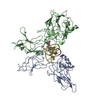 1vkxS S: Starting model for refinement |
|---|---|
| Similar structure data |
- Links
Links
- Assembly
Assembly
| Deposited unit | 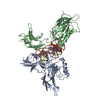
| ||||||||
|---|---|---|---|---|---|---|---|---|---|
| 1 |
| ||||||||
| Unit cell |
|
- Components
Components
| #1: DNA chain | Mass: 5269.450 Da / Num. of mol.: 1 / Source method: obtained synthetically / Details: kB DNA |
|---|---|
| #2: DNA chain | Mass: 5591.812 Da / Num. of mol.: 1 / Source method: obtained synthetically / Details: kB DNA |
| #3: Protein | Mass: 31115.236 Da / Num. of mol.: 1 / Fragment: p65 RHR Source method: isolated from a genetically manipulated source Source: (gene. exp.)   Mus musculus (house mouse) / Gene: rela / Plasmid: ET29b / Species (production host): Escherichia coli / Production host: Mus musculus (house mouse) / Gene: rela / Plasmid: ET29b / Species (production host): Escherichia coli / Production host:   Escherichia coli BL21(DE3) (bacteria) / Strain (production host): BL21(DE3) / References: UniProt: Q04207 Escherichia coli BL21(DE3) (bacteria) / Strain (production host): BL21(DE3) / References: UniProt: Q04207 |
| #4: Protein | Mass: 35056.066 Da / Num. of mol.: 1 / Fragment: p50 RHR Source method: isolated from a genetically manipulated source Source: (gene. exp.)   Mus musculus (house mouse) / Gene: nfkb1 / Plasmid: ET29b / Species (production host): Escherichia coli / Production host: Mus musculus (house mouse) / Gene: nfkb1 / Plasmid: ET29b / Species (production host): Escherichia coli / Production host:   Escherichia coli BL21(DE3) (bacteria) / Strain (production host): BL21(DE3) / References: UniProt: P25799 Escherichia coli BL21(DE3) (bacteria) / Strain (production host): BL21(DE3) / References: UniProt: P25799 |
| #5: Water | ChemComp-HOH /  Water Water |
-Experimental details
-Experiment
| Experiment | Method:  X-RAY DIFFRACTION / Number of used crystals: 1 X-RAY DIFFRACTION / Number of used crystals: 1 |
|---|
- Sample preparation
Sample preparation
| Crystal | Density Matthews: 3.86 Å3/Da / Density % sol: 68.13 % | ||||||||||||||||||||||||||||||||||||||||||||||||||||||||
|---|---|---|---|---|---|---|---|---|---|---|---|---|---|---|---|---|---|---|---|---|---|---|---|---|---|---|---|---|---|---|---|---|---|---|---|---|---|---|---|---|---|---|---|---|---|---|---|---|---|---|---|---|---|---|---|---|---|
Crystal grow | Temperature: 291 K / Method: small tubes / pH: 6.5 Details: PEG 3350, CaCl2, sodium spermine, pH 6.5, SMALL TUBES, temperature 291K | ||||||||||||||||||||||||||||||||||||||||||||||||||||||||
| Components of the solutions |
| ||||||||||||||||||||||||||||||||||||||||||||||||||||||||
| Crystal grow | *PLUS Temperature: 18 ℃ / Method: vapor diffusion, hanging drop | ||||||||||||||||||||||||||||||||||||||||||||||||||||||||
| Components of the solutions | *PLUS
|
-Data collection
| Diffraction | Mean temperature: 110 K |
|---|---|
| Diffraction source | Source:  ROTATING ANODE / Type: RIGAKU RU200 / Wavelength: 1.5418 Å ROTATING ANODE / Type: RIGAKU RU200 / Wavelength: 1.5418 Å |
| Detector | Type: MARRESEARCH / Detector: IMAGE PLATE / Date: Aug 8, 1999 |
| Radiation | Monochromator: MIRRORS / Protocol: SINGLE WAVELENGTH / Monochromatic (M) / Laue (L): M / Scattering type: x-ray |
| Radiation wavelength | Wavelength : 1.5418 Å / Relative weight: 1 : 1.5418 Å / Relative weight: 1 |
| Reflection | Resolution: 2.7→30 Å / Num. obs: 33470 / % possible obs: 98 % / Observed criterion σ(F): 0 / Observed criterion σ(I): 1 / Redundancy: 7.6 % / Rmerge(I) obs: 0.064 / Net I/σ(I): 13.8 |
| Reflection shell | Resolution: 2.7→2.8 Å / Rmerge(I) obs: 0.31 / Mean I/σ(I) obs: 2.5 / % possible all: 89 |
| Reflection | *PLUS % possible obs: 98 % / Num. measured all: 254045 |
| Reflection shell | *PLUS % possible obs: 89 % / Rmerge(I) obs: 0.315 |
- Processing
Processing
| Software |
| ||||||||||||||||||||
|---|---|---|---|---|---|---|---|---|---|---|---|---|---|---|---|---|---|---|---|---|---|
| Refinement | Method to determine structure : :  MOLECULAR REPLACEMENT MOLECULAR REPLACEMENTStarting model: PDB ENTRY 1VKX Resolution: 2.7→20 Å / Isotropic thermal model: Isotropic / σ(F): 2 / Stereochemistry target values: Engh & Huber
| ||||||||||||||||||||
| Refinement step | Cycle: LAST / Resolution: 2.7→20 Å
| ||||||||||||||||||||
| Refine LS restraints |
| ||||||||||||||||||||
| Refinement | *PLUS % reflection Rfree: 5 % / Rfactor Rwork : 0.25 : 0.25 | ||||||||||||||||||||
| Solvent computation | *PLUS | ||||||||||||||||||||
| Displacement parameters | *PLUS | ||||||||||||||||||||
| Refine LS restraints | *PLUS Type: c_bond_d / Dev ideal: 0.0072 |
 Movie
Movie Controller
Controller



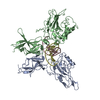

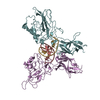


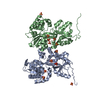



 PDBj
PDBj



























































